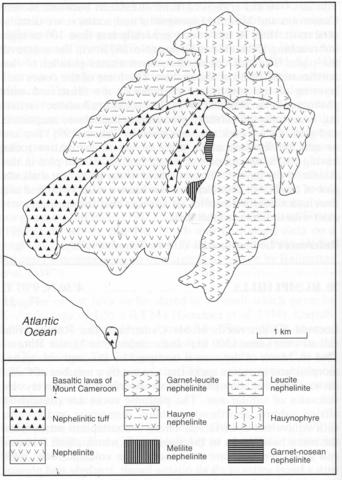stripes
Etinde is a steep-sided volcano rising to 1715 m the lower flanks of which are covered by lavas that emanated from Mount Cameroon. Etinde is built principally of lava flows, most of which have flowed southwards, with two areas of tuffs. The Etinde rocks are all highly alkaline, contain little or no olivine and there are no basalts or basanites in the sequence. The rock name 'etindite' was given by Lacroix (1923) to a lava with titanaugite and nepheline phenocrysts in a matrix of nepheline, titanaugite, leucite, magnetite, apatite, perovskite and calcite. A detailed terminology has been erected by Nkoumbou et al. (1995) based on the first full collection of in situ samples, the steepness of the terrain and density of the forest making field work difficult. These authors distinguish the following general lava types: melanephelinite, nephelinite, phonolitic nephelinite, melilite nephelinite, leucite nephelinite and hauynophyre. The melanephelinites contain phenocrysts of clinopyroxene (up to 50%), olivine (<5%), Fe-Ti oxides and microphenocrysts of mica in a groundmass of Fe-Ti oxides, pyroxene and nepheline. Nephelinites are variably porphyritic rocks with nepheline, pyroxene, Fe-Ti oxides, perovskite, leucite and titanite being common phenocryst phases; calcite and zeolite may occupy vesicles and the interstices. Some varieties contain melilite, which forms crystals (0.5-1.5 mm in length) commonly with altered rims. In garnet-melilite-bearing nephelinites the garnet may be 10% modally and with hauyne and nepheline phenocrysts reach 3-4 mm in diameter. There are also leucite-melilite-bearing nephelinites which include hauyne- and aenigmatite-bearing varieties; these phases form phenocrysts set in matrices of glass and variably melilite, perovskite, Fe-Ti oxides, garnet, carbonate, pyroxene, hyalophane and sodalite. Hauynophyres with blue hauynes are well known as beach pebbles and in stream sections but even Nkoumbou et al. (1995) have failed to locate them in situ. However, they have shown that the abundance of the hauyne increases upwards through the massif and that hauyne of the summit area is yellowish rather than blue. Xenoliths in the nephelinites of clinopyroxenite, ijolite, melteigite, nephelinite and a solitary peridotite have been identified (Nkoumbou et al., 1995). The nephelinite tuffs comprise crystals and fragments of altered lava, up to 20 cm across, in a nephelinitic cement. Microprobe analyses of pyroxene, olivine, nepheline, leucite, hyalophane, melilite, aenigmatite, biotite, garnet, titanite, perovskite and Fe-Ti oxides are given by Nkoumbou et al. (1995). Olivine varies from Fo82-85 and is nickel-poor and manganese-rich. Garnet is either schorlomite or melanite and micas are TiO2 - (about 9%) and BaO- (>10%) rich. Pyroxene, which is the dominant mafic phase in all nephelinites, is commonly zoned and varies from diopside to aegirine with notable trends of hedenbergite enrichment in most nephelinite types. Melilite is variable in composition with SrO values reaching >15% (Fitton and Hughes, 1981; Nkoumbou et al., 1995). Nkoumbou et al. (1995) give 40 rock analyses, many with REE etc., and discuss the petrogenesis of the rock suite in detail. A description of the geography and geology of Etinde is given by Gèze (1943) and a nearly full petrography by Jérémine (1943). Tilley (1953) described a nephelinite from Etinde and Smith (1970) analysed titanite, Ti-magnetite and perovskite in the same specimens with a view to determining oxygen fugacity. Halliday et al. (1988) give Rb-Sr, Sm-Nd, U, Pb and O isotopic data for a single specimen of nephelinite.
FITTON, J.G. 1987. The Cameroon line, West Africa: a comparison between oceanic and continental alkaline volcanism. In J.G. Fitton and B.G.J. Upton (eds), Alkaline igneous rocks. 273-91. Geological Society of London Special Publication 30.FITTON, J.G. and DUNLOP, H.M. 1985. The Cameroon line, West Africa, and its bearing on the origin of oceanic and continental alkali basalt. Earth and Planetary Science Letters, 72: 23-38.FITTON, J.G. and HUGHES, D.J. 1981. Strontian melilite in a nephelinite lava from Etinde, Cameroon. Mineralogical Magazine, 44: 261-4GÈZE, B. 1943. Géographie physique et géologie du Cameroun occidental. Mémoires du Muséum National d'Histoire Naturelle. Paris, N.S. 17: 1-271.JÉRÉMINE , E. 1943. Contribution a l'ètude pétrographique du Cameroun Occidental. Mémoires du Muséum National d'Histoire Naturelle. Paris, NS 17: 273-320.LACROIX, A. 1923. Minéralogie de Madagascar. 3. Lithologie Appendice - Index Geographique. Société d’Éditions Géographiques, Maritimes et Coloniales, Paris. 450 pp.NKOUMBOU, C., DERUELLE, B. and VELDE, D. 1995. Petrology of Mt. Etinde nephelinite series. Journal of Petrology, 36: 373-95.SMITH, A.L. 1970. Sphene, perovskite and coexisting Fe-Ti oxide minerals. American Mineralogist, 55: 264-9.TILLEY, C.E. 1953. The nephelinite of Etinde, Cameroons, West Africa, Geological Magazine, 90, 145-151.

